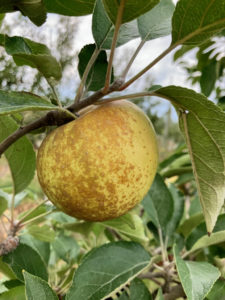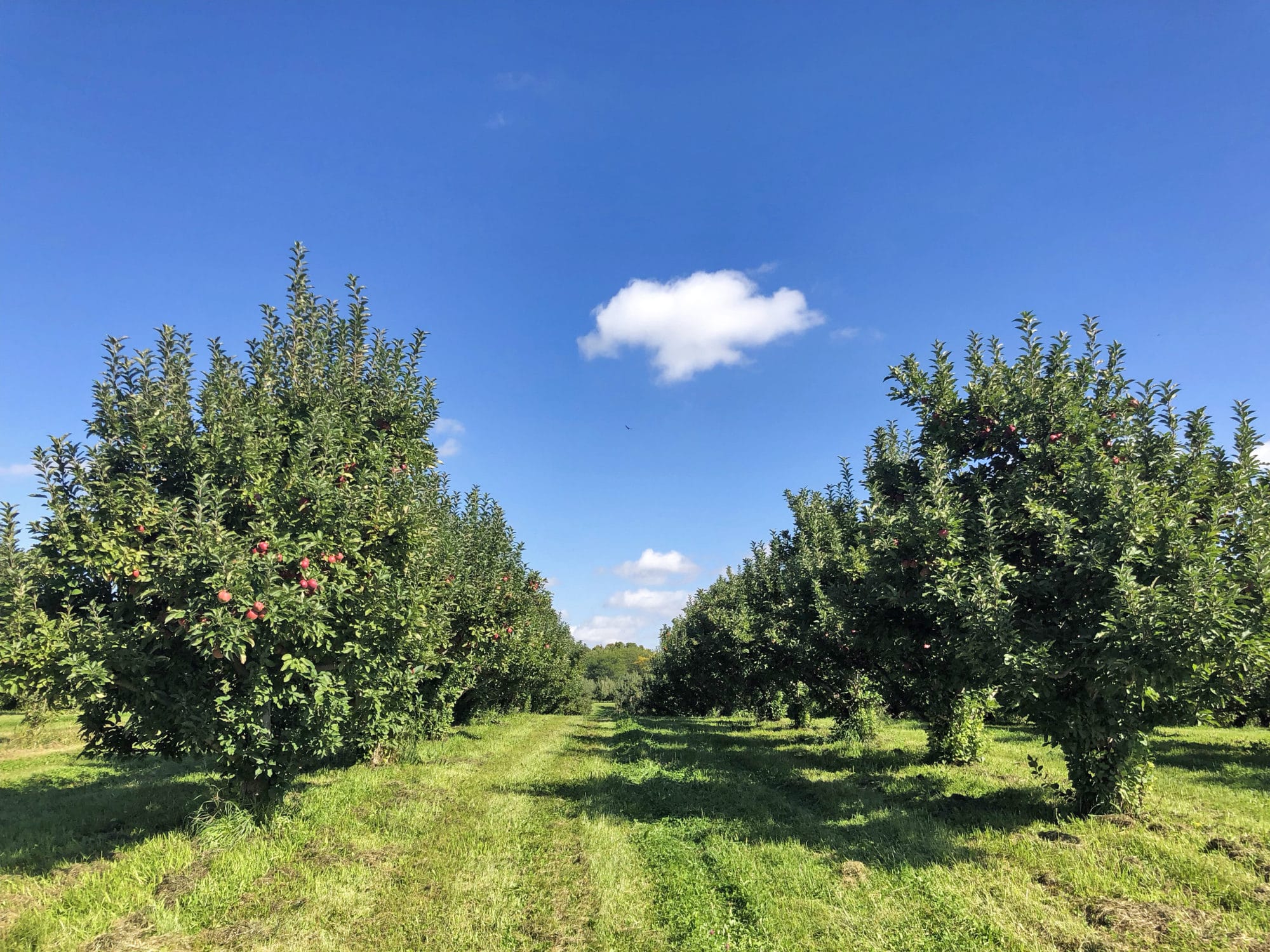The Richness of Varieties
In a modern market environment where crunch is key, what is the value of heirloom apple varieties?
Apples are astonishingly diverse. In “The Illustrated History of Apples in the United States and Canada,” apple historian Dan Bussey documents more than 16,000 unique varieties that were grown at one time in those two countries alone.
Most of these are now lost – but around 2,500 known varieties are still grown in the U.S, according to University of Illinois Extension. Many are heirloom varieties specific to a particular region or locale; a much smaller number enjoy widespread commercial success. These are the varieties more familiar to consumers – names like Gala, Red Delicious, Honeycrisp, Granny Smith and Fuji.
They owe their success, in part, to having certain attributes favored by modern consumers, like color, shape, shelf life and texture (hint: crunch is key). The economics of apple production are a big factor in determining which apples rise to prominence – variety selection can be a make-or-break decision for apple growers, But Lindsay Lee, an apple grower in the Decorah, Iowa, area, says heirloom varieties have a lot to offer.
“There is so much diversity in the apple genus,” he says. “There are flavor issues that leave some old varieties lacking, but others have a lot to offer in flavor, pest and disease resistance. Modern breeding pulls from heirloom genetics to introduce those characteristics, but sometimes those gains for some traits come at the expense of other characteristics, like flavor.”
He points to russet apples as an example, a term used to describe apples that develop rough, brown patches on the skin. Some varieties, such as Golden Russet, commonly develop this harmless skin defect, though any variety may show russeting under certain conditions. “The market has left them behind because they’re not a pretty red apple. They have a rougher skin and streaked color, but to me, they have the best flavors of any apples. They’re floral and spicy.”
Lindy, as he is called by his friends, has been working with and growing apples for more than 30 years. Recently retired, he worked years ago with PFI member David Sliwa, another Decorah-area fruit grower, to establish the original collection of heirloom apples at Seed Savers Exchange in 1989. At the time it was planted, Lindsay says the collection “focused on pre-1950 varieties with the goal of maintaining a living collection of genetic material for northern and Midwest varieties.”
What’s in a Name?
One of the varieties preserved at Seed Savers is the ancestor of today’s Red Delicious apples. Known today for its ubiquity and iconic color, this now oft-panned apple was once an accidental Iowa heirloom celebrated for its flavor and crispness. It was first discovered in the 1870s by a farmer named Jesse Hiatt, who noticed a rogue apple tree in his Peru, Iowa, orchard. After a couple of thwarted attempts to remove it (the tree kept growing back), he left it to grow.
When it bore fruit, he was delighted by the taste. He named the apple Hawkeye and entered it into a competition sponsored by Stark Bro’s Nurseries & Orchards in 1893, which catapulted it to almost instant apple stardom. Stark Bro’s purchased the rights to Hawkeye and began commercializing it, eventually renaming it Red Delicious.
Over the years, however, breeders continued to tinker with the apple. The variety whose remarkable flavor had, by the 1940s, made it the best-selling apple in the U.S. was eventually engineered for deep-red looks, a pointier shape and a tough skin that could withstand shipping. Flavor was traded for cosmetics, the unwitting victim of the apple’s popularity.
But without some curb appeal in the produce section, how is an apple to attract consumers?
To Lindsay and other heirloom apple enthusiasts, the flavor is the argument. “I’ll take a bag of 30 different varieties to classes I teach, and I’ll ask the students to taste them and identify the flavor characteristics,” Lindsay says. “I’ll put modern varieties into that mix, and the students will just not be interested in them because their flavor just doesn’t match up.”
The Business of Apples
For Red Delicious, loss of flavor didn’t hamper its commercial success. It remained the U.S.’s top-selling apple until 2018, though its decline, driven by growing dissatisfaction, started in the early 1990s. It was around that time that a new cultivar, Honeycrisp, came on the apple scene.
The fruit of a painstaking 30-year breeding process at the University of Minnesota, Honeycrisp represented a real inflection point in the apple industry. At a microscopic level, the cultivar boasts cells twice the size of older varieties, giving Honeycrisp a crunch that was previously unparalleled. “Before Honeycrisp, it was a race to the bottom in terms of price across the industry,” says PFI member Chris Deal. He and his brother Benji Deal are the fourth generation to grow up at Deal’s Orchard near Jefferson, Iowa, where the family raises over 40 acres of apples, including many newer varieties.
As a patented apple, Honeycrisp commands a higher price at the store. It also ushered in the era of club apples, also known as managed varieties. These apples are proprietary varieties that are licensed, developed and patented as intellectual property. Growers must pay membership fees, royalties per tree in production and other related expenses for the privilege of accessing markets with these apples. In some cases, production is restricted to an area for the first 20 years of commercial introduction.
“Today, Honeycrisp is a parent of most new varieties,” says Bill Dodd, president of the Midwest Apple Improvement Association, a grower cooperative that seeks to produce apples suited to Midwestern production that can compete with other club apples. Recent MAIA introductions include EverCrisp and Ludacrisp. These club apples are on trend, boasting a snappy crunch. Ludacrisp also has a flavor reminiscent of Juicy Fruit gum.
The Value of Diversity
At Deal’s Orchard, however, some increasingly rare, older varieties still grow alongside newer ones. These heirlooms continue to produce reliably and are valued for more than just their market appeal or economic contributions. One such apple is Lodi, a variety first introduced by the New York Agricultural Experiment Station in Geneva, New York, in 1924.
Chris says they’re the first apples of the season, “reliable producers” that are ready for harvest as early as late July. He appreciates the early-season marketing opportunity these summer apples provide. Benji, however, is more lukewarm, citing how the pale yellow, soft-textured Lodis don’t meet many customers’ flavor and texture expectations.
The brothers’ difference of opinion highlights some of the many factors involved in selecting apple varieties. Growers must weigh their finances, orchard size and customer base alongside a host of other considerations. Decisions about which varieties have value – or don’t – vary from orchard to orchard, and can be quite personal.
For some apple growers, having a range of varieties and products can help distribute risk. This is the case for Deal’s Orchard, which raises a mix of modern and heirloom varieties. Some apples produce better some years, Chris says, while other varieties will flourish in a different year. Pressing the fruit into juice, making apple-laden baked goods and even further processing juice into hard cider – as the Deals do – can also make better use of the produce they grow and broaden their income.
But for the Deal family, heirloom apples also have value that’s harder to quantify. “Economically, would we be okay if we raised just 10 varieties?” Chris says. “Yeah, probably. But I don’t want to do that. There is value in having more genetic diversity. And there is just something valuable about those old varieties.
“It’s a little sentimental and a connection to the past, to memories. You know, we still have folks who will drive three hours to buy the first Lodi apples of the year, and we like to see them and sell them our apples.”
In that way, choosing apple varieties from among the avalanche of options isn’t just about the horticulture or the economics; it’s also about community.
Want More on Apples?
- There is much to learn about the world of apples! Check out these sources to learn more about the apple industry and the history of apples in Iowa:
- “Good Apples: Behind Every Bite” by Susan Futrell
- “The Great American Apple Wizard: The Life and Times of Peter M. Gideon” by James R. Curran
- “An Apple a Day, for 47 Years,” The New York Times, Oct. 22, 2014.
- “Historic apple orchards at Seed Savers Exchange keep heirloom varieties alive” by Alison
Gowans. The Cedar Rapids Gazette, Aug. 19, 2020. - “The Illustrated History of Apples in the United States and Canada” by Daniel J. Bussey
Thanks to Helen Gunderson for source recommendations.



